Introduction: Reading vs Translation
It's the first day of instruction following the holiday break, and you and your students are eagerly anticipating returning to the lengthy Latin reading required for the springtime exams. You take a step back to observe how your students are approaching a new text for the first time as they turn the page to the next selection from one of the canonical Roman authors. Each student dutifully has laid out before them the Latin text, their notebook, a pencil, a Latin dictionary, and any other references or charts they might find valuable in the moment.
After 45 minutes of painstakingly progressing line by line, stopping to methodically parse verbs, note interesting uses of the subjunctive, or finally bring conclusion to that indirect statement started three lines prior, you ask your students a fairly innocuous question: ‘So, what was that about?’ You're met with a deafening silence until a brave student volunteers a rambling read of his notes. Perhaps it is at this very moment that you realise that what your students are doing is likely not at all ‘reading’ the text. Classicists, as a profession, have to concede that reading and translating are not the same thing. Translation definitively has a place in language learning, and it is an effective tool for evaluating students’ command of grammatical structures, but, at its core, it is not a comprehension activity.
Comprehension Drives Investment and Acquisition
In fact, there's a strong argument to be made that students’ inability to ‘read’ Latin at a proficient level is connected to and, at least partially responsible for, the issues around student retention and the relevancy of Classics study on both sides of the Atlantic. After all, when course content is inaccessible to most students because it is far above their proficiency level, we run the risk of creating too many barriers to them feeling successful (Krashen, Reference Krashen and Terrell1982). If a student dreads the prospect of having to ‘read’ a whole 20 lines of text in an evening, they aren't exactly viewing their progress in acquiring the language with a sense of accomplishment.
Chief among the barriers to students’ success in reading Latin is a lack of situated context in the material. Largely on account of traditional methodology that focuses on linguistic analysis of a passage over comprehension of its content, instructors are forced to break up a text into small groups of lines, which prevents any kind of narrative flow. In addition, each of those selections contains a very high percentage of new and unfamiliar vocabulary words. If we concede that for a learner to read a text fluently, 98% of the words have to be known (Schmitt, Reference Schmitt, Jiang and Grabe2011), then there is no way that students can be ‘reading’ a selection of Ovid or Vergil. Many of the texts that they encounter may not even be reaching 70% known vocabulary for most students, let alone the 90% benchmark required for effortful reading. Add to this cognitive load the occurrence of complex grammatical constructions and issues of word order or metrical patterns, and it is no surprise that as students feel incapable of understanding the material, they lose interest in it, and ultimately, they lose the desire to learn.
Understanding Proficiency Levels of Latin Texts
Should we therefore abandon all hope and toss out the Classical authors? That move would certainly make the relevancy argument to administrators and politicians nearly impossible to win, but short of taking such drastic action, we do have to do a far better job of making the content of those texts accessible and readable at the proficiency level of our students. It is worth taking the time to dig deeply into either the NCSSFL-ACTFL World-Readiness Standards (NCSB, 2015) or the ACL-SCS 2017 Standards for Classical Language Learning (ACL, 2017) to get a firm idea of how proficiency levels are delineated (which we won't do at this time), but it is safe to agree that our students are largely in the Intermediate level when they are in ‘Advanced’ classes:
‘Intermediate High learners can easily understand the main idea of paragraph-length Latin or Greek texts related to familiar topics, personal interests, and studies. They can usually follow stories and descriptions about events and experiences in various time frames.’
Breaking this out in greater detail, this means that students (after a couple of years of study) are able to read and comprehend the main idea and some supporting details about famous people, well-known myths, and historical events. They may be able to deduce the meaning of previously unseen vocabulary through context clues, but only if all of the surrounding words are familiar and known. Again, it must be emphasised that in a true act of reading, students are not labouring word-by-word but rather approaching continuous selections of texts with a sense of fluency and relative ease.
On the other hand, almost all of the texts included on the reading lists for the various exams are written for a Superior (or even a Distinguished) reader:
‘Superior learners can easily follow literary or historical texts in Greek or Latin on a wide range of both familiar and unfamiliar subjects. They can sometimes infer meaning that requires analysis and deep understanding of the culture.’
If we're being honest with ourselves, there's a good chance that even very few of us Classics instructors can pick up any text and read for fluency rather than methodically rendering it into English, often with the aid of dictionaries and commentaries. And since it is unlikely that the content of those comprehensive exams is going to change in the near future, it is essential to find a way to bridge that vast chasm between our students’ ability in the language and the texts they are expected to be able to read.
How to Bridge the Gap?
One way to bridge the gap between curricular constraints and the actual abilities of students is through tiered readings. Tiered readings are multiple scaffolded, comprehensible versions of an advanced text created to assist in reading the original. Originally created by Laurie Clarcq (Reference Clarcq2012) in a modern language instructional setting, what she calls embedded readings are designed to ‘build up’ a student through a series of parallel texts aimed at creating greater overall fluency.
Types of Tiered Readings
There are two types of tiered readings: bottom-up and top-down. Creating bottom-up tiered readings means starting with a novice level text, one that every student in the class can easily understand, then with each subsequent version adding length, detail, and complexity. Creating top-down tiered readings means starting with an advanced text in mind and creating multiple tiers by simplifying the original so that each tier contains less and less detail and complexity until you have a version that everyone in the class can easily understand. For Classicists, top-down tiered readings are generally more useful, given that our goal is to help students reach a point where they can approach a predetermined canon of unadapted Latin texts. Additionally, developing bottom-up tiered readings is significantly more time-consuming and mentally taxing than developing top-down tiered readings, as it requires the instructor to write a story from scratch, creating each new tier from their imagination.
Why Tier a Text? Benefits for Teachers and Students
Besides making it possible for students to approach authentic Latin passages with greater facility, using tiered readings has a number of other benefits, both for students and teachers. The main benefits for students are:
• Aiding acquisition by generating interest in the story: second language acquisition occurs most seamlessly when students are so engaged in a message that is comprehensible and compelling to them that they forget it is being delivered in another language (Krashen, Reference Krashen2013).
• Building students’ confidence and familiarity: when a reader knows what to expect from a story, they are much more willing and able to make deductions about unfamiliar words and grammatical constructions, even if the text they are reading is beyond their proficiency level.
• Providing repetitions of key vocabulary: by reducing the number of unique vocabulary items in a given text, an instructor can help students focus on and get lots of repetitions of the important, high-frequency words.
• Facilitating engagement with the same text in multiple ways: lower tiers help students get a solid grasp on the basic plot of the passage and provide a framework to establish the historical or literary context, while higher tiers offer an opportunity to focus on lexical and syntactic choices, as well as thematic concerns and elements of genre and style.
• Offering extra reading practice and comprehensible input: the more practice students receive with reading material that is at the appropriate level for them, the faster they will acquire a second language (Krashen, Reference Krashen2013b).
Further, there are two main benefits for teachers who use tiered readings. First, because students’ understanding of a passage is scaffolded by the lower tiers, by the time they approach the unadapted Latin, they are able to read and comprehend it - not necessarily literally translate it - without the assistance of notes or a dictionary. And second, for instructors who teach multiple levels of Latin, developing tiers for a passage can reduce workload and prep time, since the lower tiers can be used as reading material in beginning language classes.
A Step-by-Step Process for Tiering a Text
Tier 4 to Tier 3
1a. Select a suitable piece of text to tier: it should be compelling in content and contain mostly high-frequency vocabulary. For example, a good choice would be the Daphne and Apollo episode from Book 1 of Ovid's Metamorphoses (1.452ff). Instructors who use tiered texts commonly create three or four versions, labelling the original text Tier 4:
primus amor Phoebi Daphne Peneia, quem non
fors ignara dedit, sed saeva Cupidinis ira,
Delius hunc nuper, victo serpente superbus,
viderat adducto flectentem cornua nervo
‘quid’ que ‘tibi, lascive puer, cum fortibus armis?’
dixerat: ‘ista decent umeros gestamina nostros,
qui dare certa ferae, dare vulnera possumus hosti.
1b. If beginning with poetry, rearrange the word order to standard Latin prose order or any word order that will be friendlier to English speakers. If starting with a prose passage, shorten the sentence length by dividing subordinate clauses into separate sentences. Add white space between paragraphs for added ease of reading.
primus amor Phoebi Daphne Peneia, quem non ignara fors dedit, sed saeva ira Cupidinis.
nuper Delius, superbus victo serpente, viderat hunc flectentem cornua adducto nervo “quid” que dixerat “tibi, lascive puer, cum fortibus armis?
ista gestamina decent umeros nostros, qui possumus dare certa vulnera ferae, dare certa vulnera hosti.”
1c. Supply any words that need to be repeated or understood from context, especially subjects or verbs that are used in parallel constructions and forms of the verb sum, esse.
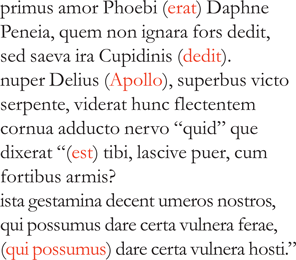
Following the steps above will produce the first tier down from the original text, Tier 3:
primus amor Phoebi erat Daphne Peneia, quem non ignara fors dedit, sed saeva ira Cupidinis dedit.
nuper Delius Apollo, superbus victo serpente, viderat hunc flectentem cornua adducto nervo “quid” que dixerat “est tibi, lascive puer, cum fortibus armis?
ista gestamina decent umeros nostros, qui possumus dare certa vulnera ferae, qui possumus dare certa vulnera hosti.”
Tier 3 in this case is likely still incomprehensible to most students; if the original text is Advanced High proficiency level, the first tier down has only been reduced to Advanced Low, at best. However, this version of the passage now becomes the foundation for creating the next tier.
Tier 3 to Tier 2
2a. Replace unusual or difficult words with more common, high-frequency synonyms and easily guessable words that have recognisable English derivatives. At this stage, each individual instructor's knowledge of their students and their curriculum will dictate the choices that they make. The teacher knows what words their students have encountered and what words they haven't, which vocabulary is coming up later on in the text or in next year's text, and which words their students will be comfortable guessing based on discussions that have occurred in the classroom. It is not necessary to replace every unfamiliar word in the passage; the focus should be on keeping high-frequency or useful vocabulary items and reducing the cognitive load of unusual words.
While it may be distressing to eliminate some of the interesting word choices made by the author, it is important to remember that a student who is struggling to comprehend the basic plot of the text will certainly not appreciate Ovid's clever selection of a particular word or phrase at this point. However, once the structure of the passage has been thoroughly scaffolded, discussions around style and rhetoric can take place while reading the next tier up.
In the passage below, the patronymic possessive adjective Peneia has been replaced with the more transparent construction filia Penei; fortuna has been substituted for fors; nuper has been replaced with recente, which has a clear English derivative; the same goes for arcum (replacing cornua) and arma (replacing gestamina); the proper name Delius was removed in favour of the more familiar Apollo.

Additional adjustments may be made: lascive and decent may not be familiar terms; students may not have encountered the poetic plural, rendering nostros and possumus syntactically opaque in this context. These decisions are up to the discretion and expertise of the instructor and will vary depending upon the class level and individual linguistic experience of the students.
2b. Simplify complex grammatical constructions and, if necessary, rewrite sentences to convey the same message in a simpler way. According to Second Language Acquisition (SLA) theory, it is more important for comprehension to shelter vocabulary than grammar, so this step is not designed to reduce the grammar to a particular level based on a sequenced grammatical curriculum. Rather, a good rule of thumb would be that if the complexity of a given construction prevents students from readily comprehending the meaning of the passage, the syntax should be simplified.
In the passage below, the difficult-to-quickly-identify causal ablative absolute victo serpente has been replaced with the more recognisable prepositional phrase ob serpentem victum. The proper name Cupidinem replaced the demonstrative pronoun hunc in order to make clear the relationship between the characters, in particular Apollo as subject and Cupid as object, as well as to reduce the likelihood of a student mistakenly thinking hunc modifies arcum. The participial phrase flectentem arcum that was originally modifying hunc has been expanded into a temporal cum clause with the subject explicitly named for clarity (cum Cupido arcum flectebat), while the temporal ablative absolute nervo adducto was replaced by a future participle plus direct object (sagittam emissurus), which can more readily be identified as describing the subject and more clearly denotes the temporal relationship between the actions described (i.e. he was bending his bow and was about to shoot an arrow). The impersonal question with a dative of reference quid est tibi cum fortibus armis? has been rephrased as a personal question with a direct object: cur tu fortia arma habes?, which is more logical for an English speaker. Finally, the parallel construction with the repeated relative clause qui possumus dare vulnera was eliminated in favour of a compound indirect object (et ferae et hosti), which is simpler and less visually overwhelming.
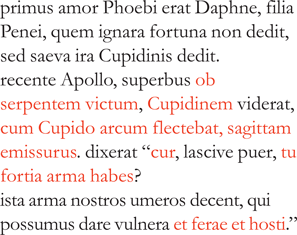
2c. Add any helpful explanatory words - names, conjunctions, pronouns - that may be missing from the text but would facilitate the reading process.
In the passage below, the names Apollinis and Cupidini were added to allow for immediate recognition of the main characters’ roles in each sentence; the relative pronoun qui, which was functioning as a sort of causal conjunction has been replaced by quod to make that relationship clear.
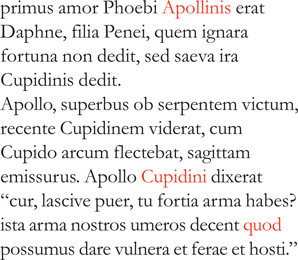
The version of the text (Tier 2) produced by the steps above is likely now Intermediate Mid/High proficiency level. As before, this now becomes the base for creating the next tier.
primus amor Phoebi Apollinis erat Daphne, filia Penei, quem ignara fortuna non dedit, sed saeva ira Cupidinis dedit.
Apollo, superbus ob serpentem victum, recente Cupidinem viderat, cum Cupido arcum flectebat, sagittam emissurus. Apollo Cupidini dixerat “cur, lascive puer, tu fortia arma habes?
ista arma nostros umeros decent quod possumus dare vulnera et ferae et hosti.”
How much the instructor modifies or leaves out between tiers will depend in large part on their students and their goals for the text. If they are going to be moving slowly through a text, they might choose to leave out suspenseful details that will keep students interested through multiple readings of the same story.
Tier 2 to Tier 1
3a. Break up most or all compound sentences. There is no need to worry about whether the passage still flows nicely without conjunctions. The purpose of this tier is to establish the bare bones of the plot; rhetorical flourishes will come later.
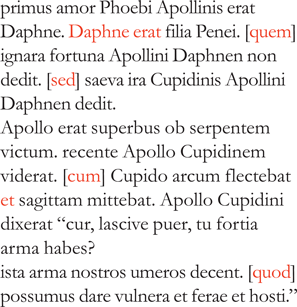
3b. Simplify complex grammatical constructions and remove unnecessary modifiers that might cause confusion or distract from the plot.
In this case, the extra name Phoebi, the adjective ignara, and the adverb recente have been removed; the prepositional phrase with perfect participle ob serpentem victum was replaced with the simpler causal clause quod serpentem superavit; all other verbs have been shifted to more recognisable present tense forms; the poetic plural possumus has been changed to ego possum for clarity.
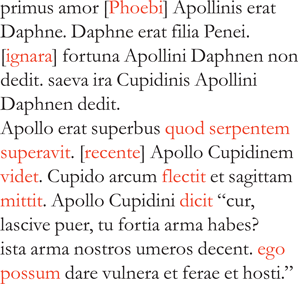
3c. Replace unknown vocabulary with high frequency synonyms or explanatory phrases.
Below, the phrase dei fluminis has been added to make the proper name Penei less intimidating; the unusual adjective lascive has been replaced with the more common pessime; fortia replaced ista in order to draw the connection more clearly to the fortia arma in the preceding sentence and decent nostros umeros was condensed to sunt mea, a simpler way of expressing the same idea. Lastly, the construction dare vulnera plus an indirect object has been replaced with the verb vulnerare plus a direct object, and the easily recognisable animalia has taken the place of ferae.
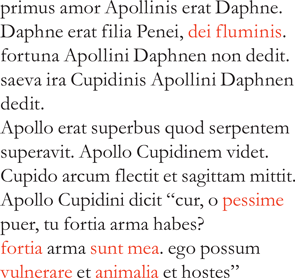
The resulting passage (Tier 1) is most likely Intermediate Low/Mid proficiency level and is suitable for Latin students who have completed a year or two of study. It is worth taking a minute to compare the Tier 1 passage here with the original text (Tier 4) in order to get a sense of just how wide the linguistic gap is between the various proficiency levels. The text here affords an accessible entry point for almost all students to read with something close to fluency, because it is appropriate for their ability level in the language. At the same time, the lower tier creates a scaffolded climb towards the text that is mandated for them to be able to translate and analyse at a high level. The context and content of the passage will be known to them prior to working with the original text; proper names or obscure references will be explained in the lower tiers, the narrative flow will be familiar, and the way the passage fits into the larger narrative will be immediately obvious. Likewise, the simplified vocabulary of the lower tiers will allow for redefinition in the target language of new vocabulary appearing in the original version, because students have a definitive reference point for the new words in the lower tiers. Lastly, the complex grammatical structures and syntax of the original text are far more approachable to the students when the other critical factors (namely context and vocabulary) have already been mitigated by this approach.
primus amor Apollinis erat Daphne. Daphne erat filia Penei, dei fluminis. fortuna Apollini Daphnen non dedit. saeva ira Cupidinis Apollini Daphnen dedit.
Apollo erat superbus quod serpentem superavit. Apollo Cupidinem videt. Cupido arcum flectit et sagittas mittit. Apollo Cupidini dicit “o pessime puer, cur tu fortia arma habes?
fortia arma sunt mea. ego possum vulnerare et animalia et hostes.”
This process could even be taken a step farther to create a Novice level version of the story. In conjunction with visual scaffolding, these short sentences could easily be used with beginning Latin students to introduce this myth.
Apollo est deus.
Apollo nympham, Daphnen, amat.
Daphne est filia Penei, dei fluminis.
Apollo, propter fortunam, Daphnen non amat.
Cupido est iratus.
Apollo, propter iram Cupidinis, Daphnen amat.
How to Use Tiered Readings in the Classroom
Now that you have a solid set of tiered readings for your students to work with, what does the typical classroom workflow look like? If we're adapting the texts to take into account a better understanding of how language acquisition works, we should also change our instructional design and pedagogy to match.
Before presenting students with a new passage of Latin, you should evaluate whether the text contains at least 90% known vocabulary (for these purposes, ‘known’ does not mean a word that students have seen once or twice, but rather, a word they have acquired and internalised). If not, it will be essential for their ability to comprehend the given selection that students spend time encountering and re-encountering the new words before they attempt to read. These encounters could take the form of a competitive vocabulary game, a small group activity that allows students to practise using the new words in Latin sentences or phrases, individual work with flashcards or other repetition tools, or any other method that allows for students to become extremely familiar with the new words. When students can easily recall the meanings of these new vocabulary items without pausing or struggling, they are ready to begin reading the lowest tier of the text.
There are a few good options for the first engagement with the text and switching between them creates a small sense of novelty and variety in approach. One of the simplest things, yet one that has a significant impact for your students, is to read the first tier of the passage out loud. Ask your students to do nothing but listen (and/or follow along with the text) with the intent of understanding as much as possible. Just hearing the Latin as a complete sense unit will hopefully curb their instincts to start moving word by word through the sentences and instead shift the focus to understanding the main idea and supporting details of the passage.
Alternatively, you could begin with something from a very old playbook of language instruction: a dictation. Tweaked to encourage comprehension, the 21st century version of a dictatio (Patrick, Reference Patrick2014) is best utilised with small selections of highly comprehensible text (i.e., the Tier 1 texts you've created from the original source). You should read the text out loud three times for the students. Their job is to write down exactly what they are hearing. The first time through, they'll have gaps as they are frantically scribbling down words. The second time through, they'll begin to fill in those gaps and instinctively they'll start to work on comprehension of the material. In the final read, the students should have a nearly complete transcript and now they are listening carefully for endings and other nuances in the language. They'll also be more focused on creating meaning and understanding from what they have written down.
The last stage of the dictatio is to project the text on a screen or whiteboard and ask the students to then carefully correct their writing with what the actual words are. This serves the important purpose of helping create better mental representation of the Latin and ensuring that incorrect forms and usage aren't being negatively reinforced. Lastly, correcting their transcripts gives the students one additional time to engage with the text before beginning to create meaning formally through comprehension checks and other techniques. In many cases, these corrections will be what the instructor assesses to hold the students accountable for doing this portion of the task with due diligence.
A third way to approach a text for the first time is to have your students read the first tier silently to themselves in order to start the process of internalising meaning. If you are providing them with paper copies of the text, having them use a highlighter to mark new or unfamiliar vocabulary words will give you a visual check of how comprehensible your vocabulary selection was for that first tier. If multiple students have many highlighted words, it could be an indicator to you that your text was still too far above their actual reading level or that you may need to engage in more pre-teaching of essential vocabulary for this particular section.
Ultimately the goal is to have the students reading and working with the text multiple times before you start the process of unpacking meaning. When students are finished reading the passage, you can reinforce key content and check for understanding by asking simple comprehension questions. For the first tier of the text, you're going to want to keep your comprehension questions at a basic level – Who? What? Where? When? Your goal shouldn't be deep and nuanced meaning, but rather ensuring that every student has a solid understanding of what the passage is actually about. Without that context in place, the next steps will not be as effective. As your students become more comfortable with this step in the process, there is also an opportunity to engage in more spoken Latin in the classroom setting. There's no reason why you couldn't ask the comprehension questions in Latin while also encouraging the students to respond in Latin. Since you are largely looking for basic factual answers, the one- or two-word responses they are likely capable of (and comfortable) producing will be right in line with their proficiency level.
Once everyone in the class has a solid understanding of the first tier, students are ready to approach the next tier on their own. In pairs or small groups, students should read aloud to one another and collaboratively talk their way through the passage, avoiding literal translation, but also keeping close to the text and trying not to simply recall aloud a summary of the overall plot. If they get stuck on a word or phrase, you can direct them back to the relevant portion of the lower tier, or encourage them to skip over the unfamiliar items and try to deduce meaning from context. At this stage, the use of dictionaries or parsing tools should be discouraged, as the intent is for students to co-create meaning for the passage holistically and not get bogged down in grammatical or lexical minutiae. If, after they have discussed the passage thoroughly, they wish to analyse certain syntactic items to add nuance to their understanding, that would be the appropriate moment to do so. While students discuss the text, you can circulate among them, offering assistance and augmenting their conversation with questions or prompts.
After all of the pairs have worked their way through the next tier, it is time to engage together with the original text (Tier 4). At this point, your discussion can become much more nuanced. You can begin by asking deeper comprehension questions (in English or Latin) – Why? How? To what extent? Compare/contrast. – or offering an analytical prompt (e.g. how does the author portray X in this passage?). You can check on students’ grasp of the details of the passage by asking them to tell you what happens in the plot and provide the relevant Latin evidence that indicates it. This would also be the moment to point out or ask questions about complex grammatical constructions, elements of rhetoric and style, or other interesting authorial choices. If you are working with poetry, you might want to go around the room reading aloud so everyone can practise pronouncing and listening to the metrical pattern.
As the instructional period ends, you may be asking yourself what a productive outside-of-class task looks like. One of the single most powerful ways to engage with the text outside of class comes by way of the Google Doc annotations originally pioneered by Roger Travis (Travis, Reference Travis, Natoli and Hunt2019) and explained in great detail in his chapter in the forthcoming publication from Bloomsbury entitled Teaching Classics with Technology. At its core, the annotations task affords the students an opportunity for doing close reading and commentary on a text in a way that keeps the focus on creating meaning from the Latin itself rather than first rendering the language into English in order to do that higher-order thinking. Explained simply, the instructor pastes a selection of Classical text into a shared document between a group of 4-5 students. Each student takes the time to either create a new comment on a word or phrase or reply to a comment by a classmate. In some cases, it's also beneficial for the instructor to seed a comment to draw particular attention to a significant feature of the text. A reasonable nightly assignment is to require a total of five comments: two created by the student and three responses to comments started by other students.
Because of the sharing feature of the Google Doc, it allows for multiple students to communicate and collaborate, creating additional opportunities for social learning. In addition, an instructor's time outside of class can be far better served reading and responding to student comments and asking additional questions of their students to extend their learning beyond what is normally possible in the standard classroom setting. Anecdotally, students throughout the years have remarked that these annotations equip them with the skills they needed to write solid responses to the short answer and literary-analysis essay questions on the AP exam. Given the nature of the questions on the GCSE, one could reasonably expect that this technique would help students feel well equipped for that exam as well.
One of the final steps in engaging with a text could come at the start of the next class meeting. Having laid the foundation of context, vocabulary, grammar, syntax, and a close reading of the nuanced cultural and historical issues at play, now would be the ideal time to engage in a literal translation of the text. This step ensures that the students can do much of the skill work that the GCSE and AP exams ask of them with respect to language control and literal translation. What the authors have found is that when the literal translation is the last step in the process, rather than the first, it becomes a far more rewarding and productive culminating experience for the students. In addition, the task itself takes far less class time to accomplish than when leading with a translation activity because of how comfortable the students already are with the text.
Conclusion
In addition to the aforementioned benefits of developing tiered readings and incorporating them into your teaching practice, there are a few other surprising and serendipitous outcomes of using these techniques that the authors have observed in our own classrooms.
First and foremost, students are no longer intimidated by large chunks of unseen Latin text. When reading continuous passages of Latin is treated as a natural activity, and one that can be accomplished without necessitating the use of external aids and resources, students no longer find it daunting to approach extended pieces of text without notes or glosses. In fact, when the drudgery of linguistic analysis is not their first experience with a Latin passage, students pick up new texts with enthusiasm and eagerness to find out what will happen next in the story.
Students who learn to read Latin in the way described above are more mentally flexible than students who learn the language in more traditional ways. These students are comfortable handling uncertainty, skipping over unfamiliar words and phrases, and reading holistically. They make deductive guesses, they interpret as they go, and they treat the text as a vehicle for meaning rather than a puzzle. They are more willing to undertake the adventure of an unseen text with the confidence that they have the skills to gather some degree of meaning from it.
Finally, because they can comprehend and are therefore completely invested in the material, and they spend so much time working through multiple tiers for any given passage, students internalise a deep and enduring understanding of each section of a text. In fact, they are able to return to a piece of text and retain detailed knowledge of it even many months later.
Creating these texts does take a great deal of time and energy on the part of the instructor. However, others have already developed a complete set of tiered readings for the AP syllabus that are freely available for teachers to use (http://links.practomime.com/caesarlist), and a variety of self-published books of tiered readings are available on Amazon. In many ways, Classics is a discipline on the brink. If we want to expand our enrolment, we must find ways to address the changing needs of our students and push ourselves to try methods that offer greater accessibility to a more diverse range of learners. Building fluency and, in turn, confidence through deliberate and realistic scaffolding of texts is one way to do just that.

